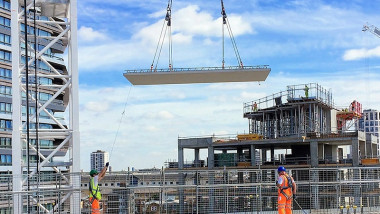Future-Proofing Core Real Estate
Key Takeaways:
- The disruption to societies and markets brought on by the pandemic has accelerated the mega-trends that will continue to impact core real estate markets for years to come
- By 2025, millennials will comprise 75% of all European employees. This cohort is sustainably-minded and has a very different concept of living and working, wanting most aspects of their lives to be contained within a single urban setting
- Core office space will still be in established business districts, close to transport hubs, but will be fitted out to reflect new priorities. Logistics assets will proliferate close to urban consumption areas. Commercial residential assets will reflect demand to sleep, work and shop within a defined area
Resources
Stable, income-producing real estate assets are still possible to find, but unearthing them requires clarity of purpose and process.
The COVID-19 pandemic has re-emphasized the need for an outlook that anticipates long-term socio-economic trends. While the pandemic has short-term implications for most asset classes, it is unlikely to derail long-term strategies and may even accelerate some of the key real estate trends.
Despite COVID-19, megatrends are here to stay
“While COVID-19 has accelerated disruption to our societies and markets, the mega-trends which will impact core real estate markets for years, and possibly decades, will remain in force,” says Christina Ofschonka, lead manager of AEW’s core European real estate strategy These mega-trends – demographic evolution, urbanisation and technology disruption – are unlikely to be knocked off course by the pandemic.
The demographic evolution has reached tipping point: babyboomers are retiring and the workplace is dominated by Generation X and millennials. By 2025, millennials will comprise 75% of all European employees. Ofschonka says: “This cohort has a very different concept of living and work spaces, and a strong consciousness about sustainability issues such as the sharing economy, scarcity of resources and climate change.”
Although urban areas have been disproportionately impacted by the pandemic, the longer-term case for urbanisation remains robust. By 2050, the urban share of population in Europe is expected to reach 82% – the same as in the US.
Europe’s cities have been incredible engines of economic growth, expanding considerably faster than non-urban areas in terms of GDP, employment and population. Despite this, city authorities are generally unable to satisfy the needs of millennials (and, increasingly, Generations Y and Z), who want most aspects of their lives to be contained within a single urban setting – sleeping, working and spending free time within a defined area.
Part of this desire for convenience will be delivered through disruptive technology, the third mega-trend impacting real estate. The trend is toward more flexible and adaptable buildings with “smart home” technologies such as air quality sensors, energy tracking, and voice technology. The need to push buttons in buildings may even disappear as smart buildings are fitted with new types of interface.
The office is dead, long live the office
These mega-trends are likely to benefit certain real estate sectors more than others: office, commercial residential and logistics.
Despite a retrenchment by workers from offices in the first half of 2020, urban office locations are not expected to suffer long-term damage. “The office environment will stay very relevant and our base case is that many people will eventually go back to the office,” says Ofschonka. “Working from home can be efficient, but important elements of teamwork and collaboration are lost.”
A proportion of the workforce will choose to work from home at least part of the time, but this should not reduce the demand for office space since more space per worker will be required. “We think this will result in a net zero change in demand for office space,” Ofschonka adds.
What is core real estate?
- For AEW, core real estate means returns to investors will come primarily from income, based on long term secured cash flows. Only a limited amount of debt will be used to enhance returns. Location is critical, with most assets in mature locations. Core office space is in established business districts, close to transport hubs and within an attractive multifunctional environment, with multi and mono tenants to manage tenant risk. Core logistics buildings are located close to urban consumption areas and multi-modal transport. Core commercial residential assets are operator-driven and are located in areas with urban dynamics and strong public transportation links. Long-term leases create more stable cashflow and tenants must have strong covenants. “We check the financial strength and health of every tenant to make sure they can fulfil their lease contract. Additionally, all assets must be flexible so they can be used by other tenants as well” says Christina Ofschonka, lead manager of AEW’s core European real estate strategy.
Work spaces will increasingly align with workers’ self-image and enhance their sense of belonging— with design, layout and location all reflecting their identity. Proven micro-locations popular with workers and close to transport hubs will be in high demand. So will up-and-coming locations, such as those close to the Crossrail project in London.
Demand to rise for commercial residential and logistics
Demand for small residential spaces is shaped by new lifestyles, including weekly commuters living far from cities and urban regeneration.
Micro and serviced living, adapted to the needs of targeted groups – such as students, young professionals, business travellers and seniors – should provide stable income and robust valuations. The increasing number of professionally-managed micro apartments with shared amenities in inner city locations is gaining further momentum with the current flexible working environment. This demand looks set to continue and has created a liquid and robust asset class.
Meanwhile, growing cities with high population densities are driving e-commerce and the pandemic has only enhanced this trend. This dynamic development in the logistics sector has created a need for central micro logistics locations to reduce the costs of last-mile delivery.
Similarly, there is demand for more localised manufacturing to reduce dependence on long-distance imports, requiring diversification of manufacturing locations. Innovative logistic buildings such as multi-level warehouses are likely to proliferate as demand for urban industrial space grows.
Global diversification requires local presence
Although Europe is a traditionally strong and varied environment for a core real estate allocation, investors can diversify at a global level. AEW’s first core regional core fund was created in the US and AEW also manages a dedicated core fund in Asia.
To support a global strategy requires teams on the ground and substantial centralised activities. In Europe, AEW is present in 12 locations with 26 dedicated investment professionals across the continent. The investment teams are supported by a pan-European platform of totalling over 420 professionals including asset managers, technical experts, researchers and legal and compliance officers.
Socially responsible investment is a key part of this real estate platform. “We don’t make a big deal of our SRI capabilities because they have long been in the DNA of AEW,” says Ofschonka. AEW has been a UNPRI signatory since 2009 and has submitted data to the Global Real Estate Sustainability Benchmark (GRESB) since 2014.
AEW has a dedicated SRI team in Paris which assesses all assets before they are purchased and applies ongoing analysis of them. Asset managers are responsible for implementing SRI strategies on the ground.
Due diligence for assets usually includes an energy audit with specific recommendations and a capex plan to make a building more efficient. The focus is on everything from emissions and waste, to electric vehicle charging, bike parking lots and green roofs. “We might employ hundreds of SRI measures depending on the asset,” says Ofschonka.
Investment professionals create an SRI section for all investment papers presented to its investment committee and to investors, including an impact analysis on the portfolio.
AEW’s core European real estate strategy is embedding sustainability measures from day one, incorporating a responsible investment philosophy for all assets under management. With clear SRI performance indicators using both internal and external reviews, the aim is to improve SRI scoring throughout the lifecycle of assets through the implementation of effective initiatives.
Conclusion: long-term income stability based on broad diversification
The target IRR of 5% - 7% for the European core real estate portfolio is based on an allocation to offices (ca. 50%), commercial residential (ca. 25%) and logistics (ca. 25%) and an LTV of around 35%. This level of return is available to fund managers who are willing to hold an asset for the longer term and, on top of the secured cash flow from strong tenants, take a hands-on approach to managing both the asset and its tenant.
The nature of the assets means that the stable income stream should also be accompanied by ample liquidity so that assets can be sold, if required, whatever the market conditions. Since AEW offers quarterly subscriptions, the strategy is available both to larger as well as smaller institutions at smaller ticket sizes.
“We can offer investors of all sizes access to European core real estate through a modern, future-proof and diversified portfolio,” says Ofschonka. “By investing in intrinsically high-quality investments in multifunctional locations, we combine liquid assets with attractive returns.”
AEW
An affiliate of Natixis Investment Managers
Privately-held French "Société anonyme à conseil d’administration"
Real-estate investment manager under n°T 8324 delivered by the Prefecture de police de Paris
Share capital: €17,025,900
RCS Paris: B 409 039 914
8-12 rue des Pirogues de Bercy 75012 Paris, France
www.aeweurope.com
AEW Ciloger
A simplified joint-stock company with capital of € 828,510
Registered under the RCS number Paris 329 255 046
Licensed by the Autorité des Marchés Financiers on July 10, 2007 under number GP-07000043.
22 rue du Docteur Lancereaux 75008 PARIS.
www.aewciloger.com
Natixis Investment Managers
RCS Paris 453 952 681
Share Capital: €178 251 690
43 avenue Pierre Mendès France
75013 Paris
www.im.natixis.com
This communication is for information only and is intended for investment service providers or other Professional Clients. The analyses and opinions referenced herein represent the subjective views of the author as referenced unless stated otherwise and are subject to change. There can be no assurance that developments will transpire as may be forecasted in this material.
Copyright © 2020 Natixis Investment Managers S.A. – All rights reserved





 Real Estate Debt Helps Investors Ride out Crisis
Real Estate Debt Helps Investors Ride out Crisis
 Why Has Making an Impact Been Made so Hard?
Why Has Making an Impact Been Made so Hard?
 European Residential: Finding a New Balance
European Residential: Finding a New Balance